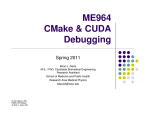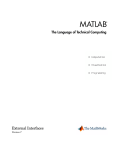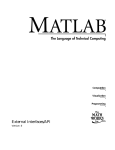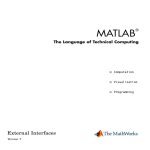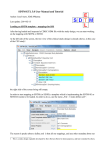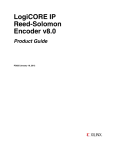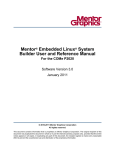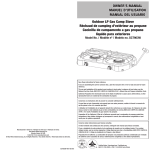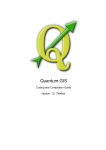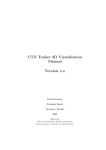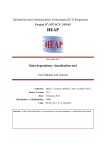Download ME964 GIT, Trac, CMake & CUDA Debugging
Transcript
ME964 GIT, Trac, CMake & CUDA Debugging Spring 2012 Brian J. Davis PhD. Candidate Biomedical Engineering Research Assistant School of Medicine and Public Health Research Area Medical Physics [email protected] © Dan Negrut, 2012 ME964 UW-Madison © Brian J. Davis 2012 What this talk is about… What I hope you to gain from it Your armed with the knowledge to program a GPU… now what? How to manage, track, build, and debug your CUDA/GPU project. Using tools like: GIT - source control management / version control software Trac - bug tracking and documentation/wiki CMake – cross platform build specification, test case, and packaging (release) tool Nsight/cuda-gdb CUDA debugging Though I may not go in depth hopefully this will provide at least some exposure to the tools that are out there 2 Source Control Management (SCM) We have resources at CAE… Use them! CAE resources https://kb.wisc.edu/cae/page.php?id=22527 Trac bug tracking with web based source browsing also supported CAE provides: Git, HG/Mercurial, Bazarr, and SVN (if you have to) 3 Trac – wiki, bug, and feature tracking Wiki – allows editing of project documentation through web browser 4 Trac – wiki, bug, and feature tracking Bug Tracking 5 Trac – wiki, bug, and feature tracking Online source browsing 6 Not all SCM tools are equal Centralized (SVN, CVS) vs. Distributed (GIT) With distributed you work offline such as on plane, sailboat, or a cabin in the woods Create a copy for a friend without ever having a remote server Deep Cloning Performance 7 Not all SCM tools are equal What you check in to the repository is what you get out. Unbelievably not all tools support this as corruption on drives, backups, or transfer to CD/DVD can cause data corruption and no integrity checking is performed. 8 GIT http://git-scm.com/ Tech Talk: Linus Torvalds on git Tortise Gui for GIT http://www.youtube.com/watch?v=4XpnKHJAok8 http://code.google.com/p/tortoisegit/ GIT Bash for Windows http://msysgit.github.com/ 9 A brief GIT How To Login to CAE account Click Repositories under Web Tools Click Create and Edit Repository Settings 10 A brief GIT How To Give the repo a name Set editing group if needed 11 A brief GIT How To Create an editing group to allow others with cae logins to access your repository Add group members 12 A brief GIT How TO Trac settings can be modified if desired Click submit 13 A brief GIT How To Trac and GIT urls will then be listed 14 A brief GIT How To GIT bash will be used for this example. Create a directory for your source http://msysgit.github.com/ Preferably a short path Without spaces I used C:\projects\ME964\ME964_2012\ trunk\ 15 A brief GIT How To Initialize a GIT repository A .git directory will be created Set your username and email address --global can be used to set for all future repositories you create on the computer you are using – it gets set in your profile cd /c/projects/ME964/ME964_2012/trunk git init git config --global user.name "Brian J. Davis“ git config --global user.email "[email protected]" 16 A brief GIT How To Add your files to git Commit the project to the local repository –a for all files –m for a message Create a bare clone of the repo List the config and look at remote.origin.url=c:/projects/ME9 64/ME964_2012/trunk/.git Change the remote url to point to the remote cae repository Push your code to the remote repository git add CMakeLists.txt git add my_dir_1 git add my_dir/*.cpp git commit -a -m "creating project“ #back out of the local repo cd ../ git clone --bare trunk/.git me964.git git config –l git config remote.origin.url https://git.cae.wisc.edu/git/me964_git $ git push origin master Username: Password: Counting objects: 135, done. Delta compression using up to 2 threads. Compressing objects: 100% (119/119), done. Writing objects: 36% (49/135) 17 A brief GIT How To Clone the remote repo to a new local copy Make changes Commit changes Push changes to remote repository git clone https://git.cae.wisc.edu/git/me964_git my_checkout # make changes …. Make changes… git commit –a –m ‘my message’ # make more changes …. Make more changes… git commit –a –m ‘my more changes message’ git push origin master 18 CMake Build tools – What do they do? What is CMake? Why use CMake? What can CMake do? Example Project Don’t listen to me go to the source… hey man I am just spreading the word. Google Tech Talk CMake/CPack/CTest/CDash Open Source Tools to Build Test and Deploy C++ Software http://www.youtube.com/watch?v=8Ut9o4OdSC0&feature=youtube_gdata I am not affiliated in any way with Kitware. I am just trying to get my code to compile on Microsoft Windows and Linux. 19 19 The Source CMake by Kitware http://www.CMake.org/ Documentation FAQ http://www.CMake.org/CMake/resources/software.html Source Repository http://www.CMake.org/Wiki/CMake_FAQ Download http://www.cmake.org/cmake/help/documentation.html http://www.cmake.org/cmake/help/cmake-2-8-docs.html http://www.CMake.org/Wiki/CMake/Git Tutorial http://www.CMake.org/CMake/help/CMake_tutorial.html “Go right to the source and ask the horse. He’ll give you the answer that you’ll 20to endorse. He’s always on a steady course. Talk to Mr. Ed” – Theme song Mr. Ed, 1961-1966 Build tools what do they do? Check dependencies You changed a source file and the .obj file needs to be rebuilt which then rebuilds the dll or exe. Controls what gets built in what order Execute generators Such as the compiler which coverts source to output files Generate configuration files Specify install and testing locations and put all files in correct locations. Generate code Lexx Yacc or Flex and Bison Extended Backus–Naur Form (EBNF) – context -free grammars SWIG C/C++/C# (Mono) Language integration in Linux Check system for build dependencies (some do VS not so much) CUDA, nvcc, Object files to be created from source Library dependencies (VTK, ITK, etc) What are capabilities/versions of C and C++ stdlib etc. Whatever you command them to do MESSAGE( “Executing world domination script now” ) execute_process( COMMAND world_domination.bat WORKING_DIRECTORY ./world_domination_scripts/milky_way_galaxy/earth INPUT_FILE world_domination.cfg OUTPUT_FILE world_domination_result.log ERROR_FILE world_domination_error.log ) 21 Build Tools What have I used? What comparisons can I make? BorlandBuilder 5.02/Builder C++ 4, and 6 MS VisualStudio GNU Make, autoconf, and friends BJam – BoostBuildV2 part of Boost C++ http://www.boost.org/boost-build2/ Perforce Software (not related to Boost) Jam Tutorial – only put here due to use of Jam http://www.perforce.com/perforce/conferences/us/2001/wingerd/WPLa ura.pdf I have not used the Perforce version only Boost’s version CMake 22 Visual Studio as a build tool >>> MY OPINIONS <<< Based on What? – ~10 years experience Great for simple projects Unwieldy for complex projects Modal Dialog boxes that can’t be resized? Build Spec is not searchable Which spec am I changing? all, debug, release? Is this for 32 or x64? What did I change that made the build break? I know I can diff the .sln and .prj files. We will take a look at those (next slide) All seems hidden behind GUI which is difficult access, change, and maintain . Especially with broad sweeping changes. Ok there is project inheritance. There is also nmake as an alternative. Good for wear leveling of your mouse buttons through increased use of right click 23 Looking at (diffing) VS project files WHEN things go wrong: .sln Microsoft Visual Studio Solution File, Format Version 10.00 # Visual Studio 2008 Project("{8BC9CEB8-8B4A-11D0-8D11-00A0C91BC942}") = "CudaCollision", "CudaCollision\CudaCollision.vcproj", "{08C6F311-7AA6-46EB-BFB9-7F947F5DD014}" EndProject Project("{8BC9CEB8-8B4A-11D0-8D11-00A0C91BC942}") = "BulletValidation", "BulletValidation\BulletValidation.vcproj", "{8644F016-E5EF-432D-98C6-91D27D459746}" EndProject Project("{8BC9CEB8-8B4A-11D0-8D11-00A0C91BC942}") = "DataGeneration", "DataGeneration\DataGeneration.vcproj", "{A0B424D7-6CCD-465C-A90E-D5589E73954E}" EndProject Global GlobalSection(SolutionConfigurationPlatforms) = preSolution Debug|Win32 = Debug|Win32 Debug|x64 = Debug|x64 Release|Win32 = Release|Win32 Release|x64 = Release|x64 EndGlobalSection GlobalSection(ProjectConfigurationPlatforms) = postSolution {08C6F311-7AA6-46EB-BFB9-7F947F5DD014}.Debug|Win32.ActiveCfg = Debug|Win32 {08C6F311-7AA6-46EB-BFB9-7F947F5DD014}.Debug|Win32.Build.0 = Debug|Win32 {08C6F311-7AA6-46EB-BFB9-7F947F5DD014}.Debug|x64.ActiveCfg = Debug|x64 {08C6F311-7AA6-46EB-BFB9-7F947F5DD014}.Debug|x64.Build.0 = Debug|x64 {08C6F311-7AA6-46EB-BFB9-7F947F5DD014}.Release|Win32.ActiveCfg = Release|Win32 … … … {A0B424D7-6CCD-465C-A90E-D5589E73954E}.Release|Win32.Build.0 = Release|Win32 {A0B424D7-6CCD-465C-A90E-D5589E73954E}.Release|x64.ActiveCfg = Release|x64 {A0B424D7-6CCD-465C-A90E-D5589E73954E}.Release|x64.Build.0 = Release|x64 EndGlobalSection GlobalSection(SolutionProperties) = preSolution HideSolutionNode = FALSE EndGlobalSection EndGlobal 24 Looking at (diffing) VS project files WHEN things go wrong: .sln <?xml version="1.0" encoding="Windows-1252"?> <VisualStudioProject ProjectType="Visual C++" Version="9.00" Name="CudaCollision" ProjectGUID="{08C6F311-7AA6-46EB-BFB9-7F947F5DD014}" RootNamespace="CudaCollision" Keyword="x64Proj" TargetFrameworkVersion="0" > <Platforms> <Platform Name="x64" /> <Platform Name="Win32" /> </Platforms> <ToolFiles> <DefaultToolFile FileName="NvCudaRuntimeApi.v3.2.rules" /> … … Blah Blah Blah GOBS and GOBS more where this came from … <File RelativePath=".\cuda_timer.cu" > </File> </Files> <Globals> </Globals> </VisualStudioProject> 25 What does VS do? Ok well .prj is better than .sln not that I don’t like looking at hash codes or anything. I counted 698 lines (ok well SciTE http://www.scintilla.org/SciTE.html line numbering did) of good wholesome xml Seriously 698 lines of xml to specify 1 executable (CollisionDetection) to generate a handfull of command lines???? Who’s selling hardrives these days… I need to invest! The point here is that this is the text output which can be viewed and diffed with diff tools and should be preferably clean and it should be a relatively short time to figure out what changed and broke the build. 26 What is CMake? From http://www.CMake.org/ “Welcome to CMake, the cross-platform, open-source build system. CMake is a family of tools designed to build, test and package software. CMake is used to control the software compilation process using simple platform and compiler independent configuration files. CMake generates native makefiles and workspaces that can be used in the compiler environment of your choice. ” Product of Kitware due to the need for a crossplatform build environment for Insight Segmentation and Registration Toolkit (ITK) as part of the Visible Human Project 27 Meta build Meta build tool A built tool that builds build files defined by build specifications (CMakeLists.txt files) CMakeLists.txt files which generate Make (Linux and friends and Nmake on Windows) or project files (VS): Borland Makefiles ,MSYS Makefiles, MinGW Makefiles, NMake Makefiles, NMake Makefiles JOM, Unix Makefiles, Visual Studio 10, Visual Studio 10 Win64, Visual Studio 6, Visual Studio 7, Visual Studio 7 .NET 2003, Visual Studio 8 2005, Visual Studio 8 2005 Win64, Visual Studio 9 2008, Visual Studio 9 2008 Win64, Watcom Wmake, CodeBlocks - MinGW Makefiles, CodeBlocks - NMake Makefiles, CodeBlocks - Unix Makefiles, Eclipse CDT4 - MinGW Makefiles, Eclipse CDT4 - NMake Makefiles, Eclipse CDT4 - Unix Makefiles First experience (before drinking the coolaid) was with cygwin where CMake bootstraped itself, built itself which was then used to generate the build files for ITK which were then used to build ITK using GNU Make. This resulted in a 4 stage to compile…. Awesome! ./bootstrap make make install Run CMake to generate Makefiles Build VTK using gnu make and makefiles I was flabbergasted and my command prompt cursor must have been exhausted. I had never seen the little guy do so much tearing across the screen to build a 3rdParty Package. Thankfully he was still blinking at the same rate as when he started, tough little bugger. I vowed never to use CMake after that… Well then 2009 rolled around and the need to use VTK, ITK, dcmtk, boost etc all of witch had versions which used CMake. Quoting Homer (Simpson not 28 Greek poet of lliad) “D’oh!” What else is CMake? What is meant by “family of tools”? CTest and CDash CPack Automated test (CTest) and reporting (CDash) http://www.cdash.org/CDash/index.php?project=CMake Package software for distributions We will focus on CMake in this talk 29 Why use CMake? Cross platform support Plain text files for build specification which can be tracked and diffed (WinMerge/Meld) easily with source control tools (git) http://winmerge.org/ http://meldmerge.org/ Code generation, configuration file generation, and text manipulation with configure_file(…) Powerful scripting Create your own generator Regular Expressions Not an exhaustive list! 30 What does CMake Look Like? # The name of our project is "HELLO". CMakeLists files in this project can # refer to the root source directory of the project as ${HELLO_SOURCE_DIR} and # to the root binary directory of the project as ${HELLO_BINARY_DIR}. cmake_minimum_required (VERSION 2.6) project (HELLO) # Recurse into the "Hello" and "Demo" subdirectories. This does not actually # cause another CMake executable to run. The same process will walk through # the project's entire directory structure. add_subdirectory (Hello) add_subdirectory (Demo) Source: http://www.CMake.org/CMake/help/examples.html 31 What does CMake Look Like? # Make sure the compiler can find include files from our Hello library. include_directories (${HELLO_SOURCE_DIR}/Hello) # Make sure the linker can find the Hello library once it is built. link_directories (${HELLO_BINARY_DIR}/Hello) # Add executable called "helloDemo" that is built from the source files # "demo.cxx" and "demo_b.cxx". The extensions are automatically found. add_executable (helloDemo demo.cxx demo_b.cxx) # Link the executable to the Hello library. target_link_libraries (helloDemo Hello) Source: http://www.CMake.org/CMake/help/examples.html 32 What does CMake Look Like? CMake provides a GUI – CMake GUI Processes root CMakeLists.txt file Not CMakelists.txt or CMakelist.txt or CMakeList.txt or CMakelists.txt or CMakelISts.TxT – remember cross platform (Linux) Allows user to interact with the build and change build parameters Build spec creator can specify their own parameters which appear in the GUI Where to build the binaries – recommended out of source builds Delete Cache button was moved to File->Delete Cache in newer versions 2.6. When generating build specs I use copious amounts of Delete Cache and wish it were still a button (speed). “I posted a desirement in the CMake Mantis bug tracker only to find out that all one has to do in CMake GUI is File->"Delete Cache" then config, config, generate, wait for CMake VS Macros to notice something is awry and update the projects... I still wish there were a button. If I could get a heart rate monitor to sense my level33 of frustration and automatically rerun a script to delete the cache I think this would be the optimal solution.” – Brian J. Davis http://comments.gmane.org/gmane.comp.lib.boost.CMake/821, 2010 CMake cache Cache is generated when all build parameters have been set in GUI. Cache generation can require multiple configure steps as when build parameters change others can be activated which require user to accept or allow the user to change Changes are in red until accepted and new ones based on user changes will appear in red Clearing the cache File->Delete Cache 34 CMake cache Why a cache? Speed – no need to reparse all CMakeLists.txt unless they change. There is a dependency on CMakeLists.txt files. Consequences: Do not track VS project files or Makefiles (CMake output) with source control management (SCM). Show of hands, Who is Using a SCM tool? Should be everyone!! Windows file explorer copy directory does not count nor does zip and copy!!! VS projects and Makefiles will be regenerated. Never Change CMake output! Except: from my understanding you can change the cache. Though not a good idea unless careful what you change. Cache is loaded when CMake is loaded to acquire previous build settings35 CMake cache Cache and SET(..) To set variables in CMake SET(..) is used set(<variable> <value> [[CACHE <type> <docstring> [FORCE]] | PARENT_SCOPE]) Example SET( MY_STR “HELLO” CACHE STRING “hello text” FORCE ) What does FORCE do? No matter what is typed in the GUI in an attempt to change the variable the variable will always be “HELLO” Be careful with FORCE as remember the cache gets reloaded when CMake is run if you decide to change a value from FORCE to not FORCED then you need to delete the cache and regenerate A non FORCE example with use of booleans SET( MY_BOOL YES CACHE BOOL “my boolean” ) Allows the user to change MY_BOOL in the GUI and have the modified value change in the cache Can also use the preferred : OPTION( MY_BOOL “my boolean” YES ) 36 Example Project Checkout using GIT https://git.cae.wisc.edu/git/me964_git Use CAE username and password Run go.bat Extracts CMake from zip archive – downloaded from CMake website. It is not modified. Launches CMake Simply for ease of use to get started Configure CMake variables such as ME964_BUILD_BOOST ME964_USE_MATLAB_INTERFACE ME964_GPU_ARCH_SM10/11/13/20 37 Example Project Click Configure Click Generate Batch scripts are created for launching: Visual Studio run_vs.bat Matlab run_matlab.bat Depwalker – run_depwalker.bat Batch scripts configure the PATH environment variables to ensure project DLLs are loaded from the install bin directory and so MATLAB can find GP_Loader.mex64 38 Example Project Browse to location of top (trunk directory) CMakeLists.txt file then to trunk\build\ME964.sln (project) trunk\source\cpp\project1 (source) Very simple example project is generated. Uses SAP (my CMake code) Submitted as feature request http://www.CMake.org/Bug/view.php?id=11807 NEVER USE SEMICOLONS AFTER COMMANDS IN CMake– can lead to all kinds of confusion as to where the error is add_project_executable( # the name of your executable project1 # Defines if you need any DEFINES MY_DEF=1 # A list of .cu sources CU_SOURCES project1.cu # A list of .cpp sources CPP_SOURCES main.cpp INCLUDE_DIRECTORIES ../include INSTALL_DIRECTORIES bin ) This is a CMake function written to simplify the common usage of creating an application. NOT part 39 of the vanilla CMake install Example Project What did I add? add_project – not fully implemented… it’s a Work in Progress (WIP) – really just a place holder for now. Goal was to have namespace resolution at least a form that would be possible in CMake by prepending variables with project name. add_project_configuration – allows specification of a configuration which can be inherited add_project_executable - creates a executable and can inherit project configurations (multiple) add_project_library – creates a library which compiles C/C++/CUDA and can inherit configurations (multiple) patch – patches files unpack – unzips .tar, .bz2, and zip Remember CMake was unmodified these scripts are in the CMake project specific directory at root of tree. CMake build tool and related source is found in platform/3rdParty/tools directory when extracted from zip archive. 40 Example Project Using Vanilla CMake Browse to location of CMAKE_HOME_DIRECTORY which is the path to top of source tree where root CMakeLists.txt file is located Delete cache if necessary (if you tried previous project) and changed something Configure and Generate project Browse to trunk\build\ME964.sln (project) trunk\source\cpp\project1_vanilla (source) Very simple example project is generated. 41 Example Project Using Vanilla CMake # Root CMakeLists.txt file # check required version of CMake CMAKE_MINIMUM_REQUIRED(VERSION 2.0) #IF(CMAKE_BACKWARDS_COMPATIBILITY GREATER 2.0.6) # SET(CMAKE_BACKWARDS_COMPATIBILITY 2.0.6 CACHE STRING "Latest version of CMake when this project was released." FORCE) #ENDIF(CMAKE_BACKWARDS_COMPATIBILITY GREATER 2.0.6) if(COMMAND cmake_policy) cmake_policy(SET CMP0003 NEW) endif(COMMAND cmake_policy) # Declare the project PROJECT(ME964) SET( MY_STR “HELLO” CACHE STRING “hello text” FORCE ) SET( MY_BOOL YES CACHE BOOL “my boolean” ) add_subdirectory( source/cpp/project_vanilla/src project_vanilla ) 42 Example Project Using Vanilla CMake cmake_policy “As CMake evolves it is sometimes necessary to change existing behavior in order to fix bugs or improve implementations of existing features. The CMake Policy mechanism is designed to help keep existing projects building as new versions of CMake introduce changes in behavior. Each new policy (behavioral change) is given an identifier of the form "CMP<NNNN>" where "<NNNN>" is an integer index. Documentation associated with each policy describes the OLD and NEW behavior and the reason the policy was introduced. Projects may set each policy to select the desired behavior. When CMake needs to know which behavior to use it checks for a setting specified by the project. If no setting is available the OLD behavior is assumed and a warning is produced requesting that the policy be set.” project(<projectname> [languageName1 languageName2 ... ] ) Sets language to be used Default C/C++ Not what I was expecting as projects can have multiple subprojects find_package(<package> [version] [EXACT] [QUIET] [[REQUIRED|COMPONENTS] [components...]] [NO_POLICY_SCOPE]) Want to know more then see policies section of reference listed below FIND_PACKAGE( CUDA ) add_subdirectory(source_dir [binary_dir] [EXCLUDE_FROM_ALL]) add_subdirectory( source/cpp/project_vanilla/src project_vanilla ) Adds the subdirectory source/cpp/project_vanilla/src containing a CMakeLists.txt file for the exe and library. Example CMakeLists.txt file to follow. EXCLUDE_FROM_ALL removes from all target such as “make all” requiring a manual build command specifying target 43 Source: http://www.CMake.org/CMake/help/CMake-2-8-docs.html Example Project Using Vanilla CMake Fairly self explanatory which is nice! Override where CMake would like to put the files default C:\Program Filles\ME964 Include directories Need to use CUDA_ADD_LIBRARY or CUDA_ADD_EXECUTABLE which is from part of FindCUDA when we called find_package( CUDA) # OVERRIDE WHERE CMake WOULD LIKE TO INSTALL THE FILES SET( CMAKE_INSTALL_PREFIX ${CMAKE_HOME_DIRECTORY}/install CACHE STRING "" FORCE ) include_directories( ../include ) SET( MY_LIB_NAME libv ) SET( MY_APP_NAME project_vanilla ) # for normal C/C++ code add_library would be used, # but since this contains a .cu file # CUDA_ADD_LIBRARY must be used CUDA_ADD_LIBRARY( ${MY_LIB_NAME} project_vanilla.cu libv.cpp ) Set link flags to export function in dll Specify where to install the app and lib in ${CMAKE_INSTALL_PREFIX }/bin and ${CMAKE_INSTALL_PREFIX }/lib respectively set_target_properties( ${MY_LIB_NAME} PROPERTIES LINK_FLAGS /export:my_entry_function ) Configure a file which uses a variable in the file throug use of syntax ${SOME_VAR}. target_link_libraries( ${MY_APP_NAME} ${MY_LIB_NAME} ) # need to export the function add_executable( ) ${MY_APP_NAME} main.cpp install( TARGETS ${MY_APP_NAME} DESTINATION bin ) install( TARGETS ${MY_LIB_NAME} DESTINATION lib ) SET( SOME_VAR "This is what gets put in run_program.bat when configured" ) When Configured the place holder in the file will be replaced with the value. 44 configure_file( run_program.txt ${CMAKE_INSTALL_PREFIX}/bin/run_program.bat ) Vanilla CMake Directory listing If you want find and grep in Windows then install Cygwin or GNUWin32 Utils. CMakeLists.txt contains both the vanilla and modified projects Creates a test application and DLL called by the application ./CMakeLists.txt ./CMakeLists.txt.example ./CMakeLists.txt.vanilla ./go ./go.bat ./install ./install/bin ./install/bin/project_vanilla.exe ./install/bin/run_program.bat ./install/lib ./install/lib/libv.lib ./README.txt ./source ./source/cpp ./source/cpp/project_vanilla ./source/cpp/project_vanilla/include ./source/cpp/project_vanilla/include/project_vanilla.h ./source/cpp/project_vanilla/src ./source/cpp/project_vanilla/src/CMakeLists.txt ./source/cpp/project_vanilla/src/libv.cpp ./source/cpp/project_vanilla/src/main.cpp ./source/cpp/project_vanilla/src/project_vanilla.cu ./source/cpp/project_vanilla/src/run_program.txt 45 Vanilla CMake Example Cont Main.cpp (below) project_vanilla.cu (left) #include <project_vanilla.h> #include <iostream> #include <cuda.h> __global__ void project1( float* data ) { int index = threadIdx.x + blockDim.x * threadIdx.y; *(data + index) = index; } #define BLOCK_SIZE 8 _EXPORT_FUNCTION void my_entry_function( void ) { float* dev_data; size_t size = BLOCK_SIZE * BLOCK_SIZE * sizeof( float); float host_data[BLOCK_SIZE * BLOCK_SIZE]; cudaMalloc( &dev_data, size ); std::cout << "entry_foo has been entered\n"; dim3 numThreads(BLOCK_SIZE, BLOCK_SIZE ); dim3 numBlocks(1, 1, 1); project1<<<numBlocks, numThreads>>>(dev_data); #include <iostream> #include <project_vanilla.h> cudaMemcpy( host_data, dev_data, size, cudaMemcpyDeviceToHost); for( int row = 0; row < BLOCK_SIZE; row++ ) { for( int col = 0; col < BLOCK_SIZE; col++ ) { std::cout << "\t" << host_data[col + row * BLOCK_SIZE]; } std::cout << std::endl; int main( void ) { my_entry_function(); std::cout << "all is well in the universe\n"; } } } cudaFree( dev_data ); 46 CMake 20/80 rule? Along the lines of Dan’s 20/80 rule This is more like the 80/1 rule 80 percent of the functions – there aren’t that many to do 1% of your total development work. This 1% of the toal work is build specification. And some of these are paired like if(), else(),elseif() etc so maybe it’s like the 40/1 (half as much) rule with the remaining 99 percent (of the number in denominator) going to coding in C++ which is what we should be doing anyway. If you look at the example there are even fewer used, but this is a simple example. CMake allows things to get much, … much more complicated which is good. Complexity when you need it simplicity when you don’t add_custom_command add_custom_target add_definitions add_dependencies add_executable add_library add_subdirectory break cmake_policy configure_file else elseif endforeach endfunction endif endmacro endwhile execute_process export file find_file foreach function if include include_directories install link_directories macro message option project return set string target_link_libraries while add_custom_command 47 CMake project regeneration If VS is open and CMake regenerates project files the dialog to the left will appear. CMake cannot be used (it is locked up) until this dialog in VS is accepted (“Yes”) and any remaining “Regenerate project” dialogs that may appear. 48 Vanilla CMake Example Cont run_program.txt which becomes run_program.bat after configure_file Note ${SOME_VAR} usage. Will be replaced with value defined in CMake when .bat file is generated cmd /k Just keeps command window from disappearing so commands can be typed after double clicking .bat file in file explorer PWD sets present working directory to current directory run_program.txt SET PWD=%CD% echo ${SOME_VAR} cmd /k Run through configure_file with some_var set to SET( SOME_VAR “Hello World” ) run_program.bat SET PWD=%CD% echo Hello World cmd /k 49 CMake Macros/Functions and Parse Arguments When writing your own functions and macros you’ll likely need the parse_arguments function http://www.itk.org/Wiki/CMakeMacroParseArguments You can probably guess what it is good for. SET(arguments hello OPTION3 world LIST3 foo bar OPTION2 LIST1 fuz baz ) PARSE_ARGUMENTS(ARG "LIST1;LIST2;LIST3" "OPTION1;OPTION2;OPTION3" ${arguments}) The parameters are then dereferenced with syntax ${ARG_LIST1} and ${ARG_OPTION2} as an example 50 CMake Commands message([STATUS|WARNING|AUTHOR_ WARNING|FATAL_ERROR|SEND_ERROR] "message to display" ...) Output shows up in Cmake GUI output window. Very handy when trouble shooting build scripts 51 CMake Commands if() else() endif() if(expression) # then section. COMMAND1(ARGS ...) COMMAND2(ARGS ...) ... elseif(expression2) # elseif section. COMMAND1(ARGS ...) COMMAND2(ARGS ...) ... else(expression) # else section. COMMAND1(ARGS ...) COMMAND2(ARGS ...) ... endif(expression) You might see this expression where beginning if and else need same expression.. I never do this and only ever put expression in first if and not in trailing else, elseif, and endif etc From CMake FAQ: “As of CMake 2.6.0 the ELSE() and ENDIF() constructs can be empty.” •There are more than thoes shown below. Just showing most commonly ones I use. Documentation is omitted see online refrence manual for more. if(<constant>) if(<variable>) if(NOT <expression>) if(<expr1> AND <expr2>) if(<expr1> OR <expr2>) if(TARGET target-name) if(EXISTS file-name) if(EXISTS directory-name) if(IS_DIRECTORY directory-name) if(IS_ABSOLUTE path) if(<variable|string> MATCHES regex) if(<variable|string> LESS <variable|string>) if(<variable|string> GREATER <variable|string>) if(<variable|string> EQUAL <variable|string>) if(<variable|string> STRLESS <variable|string>) if(<variable|string> STRGREATER <variable|string>) if(<variable|string> STREQUAL <variable|string>) if(DEFINED <variable>) if((expression) AND (expression OR (expression))) 52 CMake Commands file(WRITE filename "message to write"... ) file(APPEND filename "message to write"... ) file(READ filename variable [LIMIT numBytes] [OFFSET offset] [HEX]) file(STRINGS filename variable [LIMIT_COUNT num][LIMIT_INPUT numBytes] [LIMIT_OUTPUT numBytes] [LENGTH_MINIMUM numBytes] [LENGTH_MAXIMUM numBytes] [NEWLINE_CONSUME] [REGEX regex] [NO_HEX_CONVERSION]) file(GLOB variable [RELATIVE path] [globbing expressions]...) file(GLOB_RECURSE variable [RELATIVE path] [FOLLOW_SYMLINKS] [globbing expressions]...) file(RENAME <oldname> <newname>) file(REMOVE [file1 ...]) file(REMOVE_RECURSE [file1 ...]) file(MAKE_DIRECTORY [directory1 directory2 ...]) file(RELATIVE_PATH variable directory file) file(TO_CMAKE_PATH path result) file(TO_NATIVE_PATH path result) file(DOWNLOAD url file [TIMEOUT timeout] [STATUS status] [LOG log] [EXPECTED_MD5 sum] [SHOW_PROGRESS]) 53 CMake Commands String regex – regular expression String comparisons To Upper/Lower case string(REGEX MATCH <regular_expression> <output variable> <input> [<input>...]) string(REGEX MATCHALL <regular_expression> <output variable> <input> [<input>...]) string(REGEX REPLACE <regular_expression> <replace_expression> <output variable> <input> [<input>...]) string(REPLACE <match_string> <replace_string> <output variable> <input> [<input>...]) string(COMPARE EQUAL <string1> <string2> <output variable>) string(COMPARE NOTEQUAL <string1> <string2> <output variable>) string(COMPARE LESS <string1> <string2> <output variable>) string(COMPARE GREATER <string1> <string2> <output variable>) string(ASCII <number> [<number> ...] <output variable>) string(CONFIGURE <string1> <output variable> [@ONLY] [ESCAPE_QUOTES]) string(TOUPPER <string1> <output variable>) string(TOLOWER <string1> <output variable>) string(LENGTH <string> <output variable>) string(SUBSTRING <string> <begin> <length> <output variable>) string(STRIP <string> <output variable>) string(RANDOM [LENGTH <length>] [ALPHABET <alphabet>] [RANDOM_SEED <seed>] <output variable>) 54 ExternalProject_ADD Adds external 3rdParty packages to your projects Can download source from repositories: SVN, GIT, CVS Build and install source that it CMake friendly There is an example though not currently working (keeps rebuilding itself) using boost and svn which can be activated with ME964_BOOST_SVN_CHECKOU T_BUILD for the curious Once it was elusive and it’s documentation could only be accessed by the command prompt. ExternalProject_Add(<name> # Name for custom target [DEPENDS projects...] # Targets on which the project depends [PREFIX dir] # Root dir for entire project [LIST_SEPARATOR sep] # Sep to be replaced by ; in cmd lines [TMP_DIR dir] # Directory to store temporary files [STAMP_DIR dir] # Directory to store step timestamps #--Download step-------------[DOWNLOAD_DIR dir] # Directory to store downloaded files [DOWNLOAD_COMMAND cmd...] # Command to download source tree [CVS_REPOSITORY cvsroot] # CVSROOT of CVS repository [CVS_MODULE mod] # Module to checkout from CVS repo [CVS_TAG tag] # Tag to checkout from CVS repo [SVN_REPOSITORY url] # URL of Subversion repo [SVN_REVISION rev] # Revision to checkout from Subversion repo [SVN_USERNAME john ] # Username for Subversion checkout and update [SVN_PASSWORD doe ] # Password for Subversion checkout and update [GIT_REPOSITORY url] # URL of git repo [GIT_TAG tag] # Git branch name, commit id or tag [URL /.../src.tgz] # Full path or URL of source [URL_MD5 md5] # MD5 checksum of file at URL [TIMEOUT seconds] # Time allowed for file download operations #--Update/Patch step---------[UPDATE_COMMAND cmd...] # Source work-tree update command [PATCH_COMMAND cmd...] # Command to patch downloaded source #--Configure step------------[SOURCE_DIR dir] # Source dir to be used for build [CONFIGURE_COMMAND cmd...] # Build tree configuration command [CMAKE_COMMAND /.../CMake] # Specify alternative CMake executable [CMAKE_GENERATOR gen] # Specify generator for native build [CMAKE_ARGS args...] # Arguments to CMake command line [CMAKE_CACHE_ARGS args...] # Initial cache arguments, of the form -Dvar:string=on #--Build step----------------[BINARY_DIR dir] # Specify build dir location [BUILD_COMMAND cmd...] # Command to drive the native build [BUILD_IN_SOURCE 1] # Use source dir for build dir #--Install step--------------[INSTALL_DIR dir] # Installation prefix [INSTALL_COMMAND cmd...] # Command to drive install after build #--Test step-----------------[TEST_BEFORE_INSTALL 1] # Add test step executed before install step [TEST_AFTER_INSTALL 1] # Add test step executed after install step [TEST_COMMAND cmd...] # Command to drive test #--Output logging------------[LOG_DOWNLOAD 1] # Wrap download in script to log output [LOG_UPDATE 1] # Wrap update in script to log output [LOG_CONFIGURE 1] # Wrap configure in script to log output [LOG_BUILD 1] # Wrap build in script to log output [LOG_TEST 1] # Wrap test in script to log output 55 [LOG_INSTALL 1] # Wrap install in script to log output #--Custom targets------------[STEP_TARGETS st1 st2 ...] # Generate custom targets for these steps ) Some points about CMake Flexible and powerful through use of a few commands There are more CMAKE_ variables see doc for more info Build settings are local to the directory. What does this mean? Build settings specified are “Global” to the directory unless set_target_properties is used set_target_properties useful when you have 2 libs which use same source file with #ifdefs and you want to build them with different settings. Settings can have build configuration specific settings such as LINK_FLAGS_<CONFIG> LINK_FLAGS_DEBUG LINK_FLAGS_RELEASE Beware of CACHE FORCE and clear cache if you think something is not quite right. IMO - Needs the concept of namespaces as CMake variables can grow in large projects project() is not what I expected add_project – does not work for third party packages such as vtk, dcmtk, ITK etc and ExternalProject_Add must be used. This IMO does not allow to build for only what you need. - No true dependency checking across files. What gets build is all or none. Use fully qualified names for paths NOT relative. Try relative first, but when it doesn't work switch to fully qualified names. Tar was supported in CMake –E, but not zip – used for unpacking source zip and tarballs. Watch for deprecated functions. Mostly what I see is consolidation (consolidating functions into one and increasing parameters) which makes sense. 56 MATLAB / C++ interface The example project provides a MATLAB / C++ interface. Activate by enabling ME964_USE_MATLAB_INTERFACE by using search bar in Cmake GUI Uses a template class mex_matrix<T> mex_matrix<float> data_matrix( &prhs[MATRIX_DATA_INDEX] ); #include <mexlib/mex_matrix.h> Example simply copies a source array to a destination array however by using the T* get_ptr() function copying data to device memory is straight forward. 57 MATLAB / C++ interface Including the full cuda/matlab test example would have pulled in too many dependencies from my code base so I have the example leaving off at the MATLAB / C layer mex_c_interface.m in the directory source\Matlab\test_cases\mex_c_interface contains the matlab test code 58 MATLAB / C++ interface Sets the mex plugin to be loaded by GP_Loader GP_Loader allows for a generic dll loader to call the mex_function and allows swapping of dlls out from under Matlab so long as GP_Loader is set to build last addpath(genpath( '../../../../' )) %% x_dim = 4 y_dim = 5 z_dim = 2 num_elements = x_dim * y_dim * z_dim; array = 1:num_elements array = reshape(array, [x_dim y_dim z_dim] ) orig_array = array size(array) %% dims = size(orig_array) %% clc array = single( array ) plugin = 'mex_interface_plugin_test'; ret_array = GP_Loader( plugin, array ); ret_array == array size( orig_array ) size( ret_array ) if( isempty( find((ret_array ~= array)) ) ) disp( 'TEST PASSED') else disp( 'TEST FAILED') end 59 MATLAB / C++ interface Enabeling ME964_USE_MATLAB_INTERFACE in CMake will generate projects boost_1_41_0 GP_Loader matrix_test_app matrixlib mex_interface_plugin_test mexmatrixlib utility 60 MATLAB / C++ interface mex_function is entry point that GP_Loader seeks to find. Note that the standard MATLAB function is mexFunction as it is inside GP_Loader Shows use of print_array(), print_dimensions() and get_data_ptr(). Print calls use LOG_EVENT and are written to log file as defined by log_file_name = "me964.log"; in event_logger.cpp as built in the utility library Use mxReal for real data and mxComplex for complex data. Complex data was tested with FFT library so this should work. Here data_t is: typedef float data_t; /* Gateway function */ #ifdef __cplusplus extern "C" { #pragma message( "building for C++" ) #endif void mex_function ( int nlhs, mxArray *plhs[], int nrhs, const mxArray *prhs[] ) { try { // Check if there are the correct number of arguments if( !check_number_matricies( NUM_ARGS, nrhs ) ) return; // create a matrix object for the projection data mex_matrix<data_t> data_matrix( &prhs[MATRIX_DATA_INDEX] ); LOG_EVENT( LOG_STATUS, "matrix dimensions\n" ); data_matrix.print_dimensions(); data_matrix.print_array(); if( nrhs > 0 ){ mex_matrix<data_t> ret_data_matrix( &plhs[0], data_matrix.get_dimensions(), mxREAL ); memcpy( ret_data_matrix.get_data_ptr(), data_matrix.get_data_ptr(), ret_data_matrix.get_size_in_bytes() ); } } catch( std::exception& e ) { LOG_EVENT( LOG_ERROR,"Error: %s\n", e.what() ); } LOG_EVENT( LOG_STATUS, "=================== TEST END ======================\n" ); } #ifdef __cplusplus } #endif 61 CUDA Debugging Bug types Why use a debugger? Where did printf go? Current state of tools NSight cuda-gdb OpenCL “I might at this point be better off programming an 256x256x256 array of industrial robots to move around beads on a matched series of abacuses. At least I could physically see where the problem was occurring.” -- Brian J. Davis, NVIDIA Developer Zone posting: [NSIGHT Confused by ? shows ??? I know I am 62 confused] - 2011 Bug types Bohr bug – “A repeatable bug; one that manifests reliably under a possibly unknown but well-defined set of conditions. Antonym of heisenbug;” Heisenbug - “A bug that disappears or alters its behavior when one attempts to probe or isolate it. (This usage is not even particularly fanciful; the use of a debugger sometimes alters a program's operating environment significantly enough that buggy code, such as that which relies on the values of uninitialized memory, behaves quite differently.) Antonym of Bohr bug” Mandelbug (Mandelbrot) – “A bug whose underlying causes are so complex and obscure as to make its behavior appear chaotic or even non-deterministic.” Schroedinbug (Schroedinger's Cat thought-experiment) – “A design or implementation bug in a program that doesn't manifest until someone reading source or using the program in an unusual way notices that it never should have worked, at which point the program promptly stops working for everybody until fixed. Though (like bit rot) this sounds impossible, it happens; some programs have harbored latent schroedinbugs for years.” Phase of the Moon bug – “The phase of the moon is sometimes spouted as a silly parameter on which a bug might depend, such as when exasperated after trying to isolate the true cause. The Jargon File documents two rare instances in which data processing problems were actually caused by phase-of-the-moon timing.” Think Y2K. Yes computers do manifest certain weird behavior based on the alignment of the planets Statistical (Stat) bug – “Statistical bugs can only be detected in aggregates and not in single runs of a section of code. These are bugs that usually affect code that is supposed to produce random or pseudo-random output.” Source: http://en.wikipedia.org/wiki/Jargon_File Jargon File - http://www.catb.org/jargon/ http://www.dourish.com/goodies/jargon.html The Meaning of hack: http://www.catb.org/jargon/html/meaning-of-hack.html 63 Why use a debugger? Clean code – no need to sprinkle with printf, #ifdef _DEBUG… #endif, or macros Zero in on the thread, block, and grid (ID) that is causing the problem and see state of variables. Set watch points and if equals, less, and more (boolean) operations etc If it (Language) does not have a debugger in this day and age I don’t use it. i.e. I don’t waste my time (except for playing Angry Birds, but that’s a choice). SAVE TIME! SAVE TIME! SAVE TIME! That can be better utilized playing Angry Birds or sailing. 64 Where did printf go? Removed prior to 3.0? (not sure exactly) release NVIDIA CUDA Linux Release Notes Version 3.1 Added the ability to call printf() from kernels. This feature is supported only on the Fermi architecture. Even a better question why printf in the first place? Let’s think about this for a second. Which thread in what block int the grid is this printf running? When does it run? Might need it in he future so add a #define #ifdef #endif. Result = messy code Without if statements this can generate a lot of text. How do I read this text? This text has to be copied over to the CPU. Who’s going to read all that text? Even armed with grep… not me. Should be optimizing GPU code for calculation throughput not printf statements 65 Current Tools From NVIDIA’s Website : http://developer.nvidia.com/to ols-ecosystem#Debugging There are likely more as this is not meant to be an exhaustive list and discussion of every debugger This talk will focus on 2 Parallel Nsight cuda-gdb Visual Profiler was covered in a previous talk 66 Parallel Nsight CUDA C/C++ Debugging CUDA Kernel Trace/Profiling Data breakpoints for CUDA C/C++ code OpenCL Kernel Trace/Profiling – OK but what about debugging? Now with VS 2010 support 67 Nsight Monitor and Debugger Nsight monitor must be started before the program to be debugged can be launched Nsight debugger attaches to monitor Secured Connections Allows only certain computers to connect File synchronization Needed if remote debugging and dlls, config files, etc are needed. 68 Nsight Configuration Nsight Monitor Headed Mode - now called Local Mode Can be used when computer has more than 1 GPUs installed WDDM TDR “TDR stands for Timeout Detection and Recovery. This is a feature of the Windows operating system which detects response problems from a graphics card, and recovers to a functional desktop by resetting the card. If the operating system does not receive a response from a graphics card within a certain amount of time (default is 2 seconds), the operating system resets the graphics card. Before TDR existed, problems of this nature would have resulted in a system freeze and required a reboot of the operating system. If TDR is enabled and you see the TDR error message "Display driver stopped responding and has recovered", this means that the Windows operating system reset the display driver.” – refrence Nsight User manual TDR crashes will also be seen on long running kernels on single gpu computers Headless Mode - now called Remote Mode Used when there is no display Connections are made remotely from client running Nsight – I have not tried this… yet as I run headed mode with multiple GPUs 69 Nsight Requirements From: http://http.developer.nvidia.com/ParallelNs ight/1.51/UserGuide/HTML/webframe.html OS Windows® Vista (32 or 64-bit) with SP1, or Windows® 7 (32 or 64-bit), or Windows HPC Server 2008 (32 or 64-bit) Local debugging (Headed Mode) (host and target on same machine) 2 GPUs, each must be either a G92, GT200, or GT400 GPU. See below for supported graphics cards. Remote debugging (Headless Mode) (host and target on different machines) On the target machine: On the host machine (with Visual Studio): 1 GPU on target machine: must be a G92, GT200, or GT400 GPU* 1 GPU on host machine: can be any GPU Current supported cards at left 70 Nsight Requirements From: http://http.developer.nvidia.com/ParallelNs ight/1.51/UserGuide/HTML/webframe.html Disable D3D acceleration for WPF (applies to local debugging only) Open Windows Explorer. Browse to the Common folder: Double-click on the file named: On a Windows 32-bit system browse to: C:\Program Files\NVIDIA Parallel Nsight 1.51\Common On a Windows 64-bit system browse to: C:\Program Files (x86)\NVIDIA Parallel Nsight 1.51\Common DisableWpfHardwareAcceleration.reg Known working from experience: Foxconn destroyer motherboard with onboard NVIDIA® 780a SLI Chipset and 4 Tesla c1060s works just fine. Also now Remote Desktop debugging works without device enumeration issue. Headed GPU is not enumerated when running remote 71 Nsight in Action - Debugger 72 http://developer.nvidia.com/parallel-nsight-videos Nsight in Action - Profiler 73 http://developer.nvidia.com/parallel-nsight-videos cuda-gdb More evolved than Nsight - though v2.0 is promising Released before Nsight DDD with cuda-gdb ddd --debugger cuda-gdb Emacs – below text is from the url at the bottom of the slide. CUDA‐GBD works with GUD in Emacs and XEmacs . No extra step is required besides pointing to the right binary. To use cuda‐gdb, the ʹgud‐gdb‐command‐nameʹ variable must be set to ʺcuda‐gdb ‐‐ annotate=3ʺ. Use M‐x customize‐variable to set the variable. Ensure that cuda‐gdb is present in the Emacs/XEmacs $PATH. http://developer.download.nvidia.com/compute/cuda/4_0_rc2/toolkit/docs/cud 74 a-gdb.pdf pg 16 cuda-gdb Remote ssh – for instance I remote debug my single gpu on my laptop using a remote ssh session I have had success using this method ssh –X usernam@wherever Stop your display manager (Ubuntu 10.10 x64 cmd shown below using gnome) sudo stop gdm set PATH and LD_LIBARY_PATH as necessary ddd –debugger cuda-gdb app_name 75 OpenCL – er what? Q: Is there a OpenCL debugger? There is some support for OpenCL in Parallel Nsight Remember what I said. If it doesn't have a debugger I don’t use it. When OpenCL does then I’ll switch. http://developer.nvidia.com/cuda-faq 76












































































